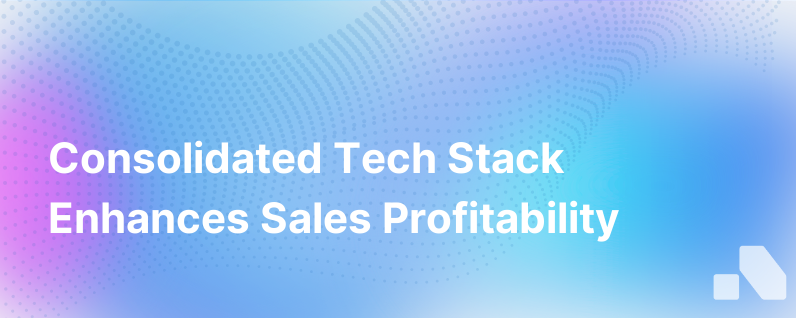How A Consolidated Tech Stack Can Boost Sales Profitability
Published on December 27, 2023 by Sawyer Middeleer
In today’s fast-paced sales environment, companies are inundated with tools claiming to optimize every aspect of their sales cycle. But rather than creating a well-oiled sales machine, this proliferation of technology often leads to a frayed tech stack, with disparate systems causing more inefficiency than improvement. Integrating these tools into a consolidated tech stack can be transformative, providing your sales team with not just a streamlined way of working, but also boosting sales profitability significantly.
A consolidated tech stack reduces friction, removes redundancies, and provides deeper insights into the sales process — all of which contribute to making your sales team more effective and your business more profitable. In this article, we’ll explore the benefits of a unified sales technology stack and the impact it can have on your bottom line.
Enhancing the Sales Experience through Integration
Integration is the cornerstone of a consolidated tech stack. By syncing different technologies, like CRM systems, communication platforms, and data analysis tools, sales representatives can access all they need from a unified interface. This convenience leads to a smoother sales process, reduces the risk of error from data re-entry, and shortens the sales cycle by ensuring that all necessary information is at the sales professional’s fingertips.
Data Visibility and Insights
Data is the currency of modern sales, and a consolidated tech stack ensures that it’s being utilized to its fullest potential. When systems are integrated, data flows seamlessly from one platform to another, eliminating silos that hinder analysis and decision-making. Real-time data visibility enables sales teams to respond to market and customer changes with agility and precision. Insights driven from a singular data-source ensure consistency in forecasting, pipeline management, and performance tracking, driving smarter, more profitable sales decisions.
Streamlining Workflow and Improving Productivity
Disconnected systems create bottlenecks as sales reps juggle multiple interfaces and redundant administrative tasks. A consolidated stack removes these inefficiencies by streamlining workflows. Automation of routine tasks, such as data entry, scheduling, and follow-ups, frees up sales representatives to focus on relationship-building and closing deals — activities that directly contribute to revenue generation.
Enhancing Training and Ramp-up Times
For new salespeople, learning multiple platforms can be daunting and time-consuming. A unified tech stack simplifies the training process, allowing them to get up to speed faster, which in turn shortens the time to their first closed deal. Quicker ramp-up times mean better sales productivity and profitability across the board.
Reducing Technology Costs
Every SaaS product comes with a subscription fee. Ununified stacks can result in overlap, with multiple tools providing similar services. By consolidating, companies can simplify their technology expenses and reduce the overall cost. A leaner tech stack that fulfills all the sales team's needs more effectively can be far more cost-efficient than a larger suite of barely used tools.
Personalization at Scale
A consolidated tech stack can leverage customer data from various touchpoints to tailor interactions, ensuring that communication is relevant and personal. This capability is particularly essential in B2B sales, where expectations for personalized outreach are higher. Personalization at scale can significantly improve engagement, nurturing leads more effectively through the sales funnel towards a profitable close.
Enhanced Collaboration and Communication
Sales doesn’t operate in a vacuum. Seamless collaboration with marketing, customer success, and other departments is critical. A unified system facilitates this collaboration, ensuring that all stakeholders are aligned and moving towards common goals. Improved communication leads to a more cohesive company approach to customer acquisition and retention, both of which positively impact sales profitability.
Superior Customer Experience
The cumulative effect of a well-integrated tech stack is a superior customer experience. With a full view of the customer journey, sales reps can provide thoughtful, timely interactions that move leads through the sales funnel. Happy customers are more likely to become repeat buyers and offer referrals, both of which drive profitability.
Easier Scaling and Flexibility
As businesses grow, their technology needs evolve. A consolidated tech stack built on flexible platforms can scale up (or down) to meet the changing needs of the sales department. Cloud-based services, for example, can adjust their capabilities to suit your business size and sales volume, providing the right amount of support at every stage of your growth trajectory.
Risk Mitigation and Compliance
From a risk management standpoint, consolidated tech stacks are easier to monitor for data breaches and compliance issues. This centralized oversight ensures that companies can maintain high standards for data security, an increasingly important consideration in the wake of many high-profile data breaches and with stringent regulations like GDPR.
Conclusion
By breaking down silos and removing inefficiencies, a consolidated sales tech stack creates an environment where both reps and managers have the confidence that they’re working with the best available tools and data. The ultimate goal of any sales technology is not merely to sell, but to do so in the most efficient and profitable manner possible—something a consolidated tech stack is uniquely well-positioned to achieve.
As businesses continually aim to optimize their sales processes and profitability, the integration and simplification provided by a consolidated tech stack are not just beneficial but essential. It’s an approach that drives sales efficiency, fosters deeper customer connections, and ultimately boosts revenue, all while creating a sustainable platform for future growth.